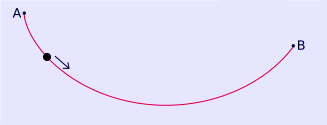.
Brachistochrone

Brachistochrone
A Brachistochrone curve, or curve of fastest descent, is the curve between two points that is covered in the least time by a body that starts at the first point with zero speed and passes down along the curve to the second point, under the action of constant gravity and ignoring friction.
The brachistochrone is the cycloid
Given two points A and B, with A not lower than B, there is just one upside down cycloid that passes through A with infinite slope, passes also through B and does not have maximum points between A and B. This is the brachistochrone curve. The brachistochrone thus does not depend on the body's mass or on the strength of the gravitational constant.
The problem can be solved with the tools from the calculus of variations.
Note that if the body is given an initial velocity at A, or if friction is taken into account, the curve that minimizes time will differ from the one described above.
Proof
According to Fermat’s principle: The actual path between two points taken by a beam of light is the one which is traversed in the least time. Hence, the brachistochrone curve is simply the trajectory of a beam of light in a medium where the speed of light increases following a constant vertical acceleration (that of gravity g). The conservation law can be used to express the velocity of a body in a constant gravitational field as:
![]() ,
,
where h represents the altitude difference between the current position and the starting point. It should be noted that the velocity does not depend on the horizontal displacement.
According to Snell's law, a beam of light throughout its trajectory must obey the equation:
![]()
for some constant K, where θ represents the angle of the trajectory with respect to the vertical. Inserting the velocity expressed above, we can draw immediately two conclusions:
1- At the onset, when the particle velocity is nil, the angle must be nil. Hence, the brachistochrone curve is tangent to the vertical at the origin.
2- The velocity reaches a maximum value when the trajectory becomes horizontal.
For simplification purposes, we assume that the particle (or the beam) departs from the point of coordinates (0,0) and that the maximum velocity is reached at altitude –D. Snell’s law then takes the expression:
![]() .
.
At any given point on the trajectory we have:
![]() .
.
Inserting this expression in the previous formula, and rearranging the terms, we have:
![]() .
.
Which is the differential equation of the opposite of a cycloid generated by a circle of diameter D.
History
Galileo incorrectly stated in 1638 in his Two New Sciences that this curve was an arc of a circle. Johann Bernoulli solved the problem (by reference to the previously analysed tautochrone curve) before posing it to readers of Acta Eruditorum in June 1696. Four mathematicians responded with solutions: Isaac Newton, Jakob Bernoulli (Johann's brother), Gottfried Leibniz and Guillaume de l'Hôpital. Three of the solutions (excluding l'Hôpital's) were published in the May 1697 edition of the same publication.
In an attempt to outdo his brother, Jakob Bernoulli created a harder version of the brachistochrone problem. In solving it, he developed new methods that were refined by Leonhard Euler into what the latter called (in 1766) the calculus of variations. Joseph-Louis de Lagrange did further work that resulted in modern infinitesimal calculus.
Another rivalry, between Newton and Leibniz, also contributed to this development. Each claimed to have solved the brachistochrone problem before the other, and they continued to quarrel over their subsequent work on the calculus.
Etymology
In Greek, brachistos means "shortest" and chronos means "time".
See also
* Calculus of variations
* Tautochrone curve
Links
* Eric W. Weisstein, Brachistochrone Problem at MathWorld.
* Iagsoft's "Brachistochrone Construction" (Java applet)
* [1] (in French but has an excellent animated illustration)
Undergraduate Texts in Mathematics
Graduate Studies in Mathematics
Retrieved from "http://en.wikipedia.org/"
All text is available under the terms of the GNU Free Documentation License

